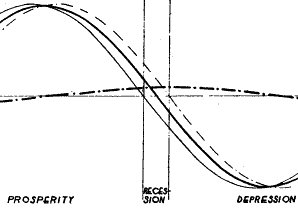|
Back Clement Juglar (1862) was among the first to call for an "economic" theory of the cycle. He himself found the business cycle to be related to the credit cycle. However, Juglar had no explanation of the credit cycle - he only posited that a relationship existed. However, to simply associate the business cycle to another cycle does not explain how either come about. But with Say's Law in place, it was virtually impossible to have elastic credit and without that, the idea of a credit cycle may be lost. Among the first theorists to break Say's Law was Knut Wicksell - whose credit theory liberated investment from the shackles of savings. Although Wicksell's "cumulative process" has no natural turning points (it is put right by banks or government), he provided the key insight that was to guide further cycle theories. Wicksell's insight of the "freedom" of investment enabled by credit was attained independently by Mikhail I. Tugan-Baranovsky (1894). He was also the first to come clear on the fact that he would take output fluctuations (more specifically, the fluctuation in the production of iron) as the indicator of the cycle. Thus, Tugan-Baranovsky provided the first theory of output fluctuations. Expansions, he argued, were derived from sudden and massive finance-induced spurts of investment (or, to use his terms, "free capital" or loanable funds were transformed into "fixed capital" or machinery, etc.). This led to a boost in the capital goods industry and, by a process akin to the later Keynesian multiplier, the economy as a whole followed. The peak of the cycle and the beginning of the recession, he claimed, rise when the financing runs out but the capital-producing industries which have been built up are still running. With lower investment demand, these industries begin to falter and, by a reverse multiplier-like process, take the rest of the economy down with them. During this period, loanable funds are built up in banks again (the savings come from those on fixed incomes who gain during the accompanying deflation) and the economy gets ready for another expansion - which begins once the banking sector's nerve is drawn up and they begin to lend again. Tugan-Baranovsky caused something of a stir among his fellow Marxians with this idea as it took away the secular trend to "crisis" in capitalism. But something was still missing: what really precipitates the sudden increases in bank credit? Arthur Spiethoff proposed this impulse to be exogenous - created by technological inventions or the discovery of new markets. These factors, which increase the profitability of industry, is what finally pulls the banks out of their slumber and initiate an explosive credit expansion. In Wicksellian terms, Spiethoff argues basically that from a position of equilibrium where the "natural" rate of interest equals the "money" rate, i.e. r = i, then technical change comes in to bring up the natural rate so that r > i, and thus set off the investment boom. The downturn begins for roughly the same reasons: the needs of these "new" industries are met, the rest follows as in Tugan-Baranovsky. If this last point sounds suspiciously like Schumpeter's (1911) growth theory, there is a difference which Schumpeter spells out in his 1939 Business Cycles: namely, inventions and new markets are all pointless unless they are actually exploited by entrepreneurs and, in Schumpeter's theory, entrepreneurs move "like swarms". Thus, the "sudden" credit expansion arises because of the sudden movement en masse of the entrepreneurs to adopt a particular technique or exploit some uncertain opportunity. The downturn arises when the "supply" of entrepreneurs in any particular society or generation is used up. Gustav Cassel (1918) took the Spiethoff treatise to a new level. Beginning on the same ground, Cassel argued the downturn arises because investment has outstripped savings during the boom. The ensuing rise in interest rates makes previously profitably-looking projects unprofitable. This is what leads entrepreneurs to stop investing and begins the downturn. Dennis H. Robertson (1915) also followed Spiethoff's lead, but later (Robertson, 1926), he focused his concentration on money as a propagator and amplifier of the fluctuations generated by credit-expansions. Investors, he claimed, make investment decisions, but the implementation of these decisions take a long time and require huge bundles of capital which are accompanied by huge loans. This puts them in a precarious position and any mistakes will naturally have large repercussions. The amplification of the cycle arises partly because of this and partly because the monetary expansions, to accompany credit, lead to price rises which are an "illusory inducement to expansion" (Robertson, 1926: p.90). In other words, price variability may confuse an investor induce him to make errors. Fluctuations, Robertson famously claimed, may be natural and even good, but its their amplification via the errors induced by the "fragility" of an investor and the confusing signals sent by a monetary system that make it inappropriate. The Juglar-Tugan-Baranovsky-Spiethoff theory was followed up by two further strands. One is Friedrich A. Hayek's (1928, 1931) theory of the cycle, which adopts the same structural change approach to generate the cycle, but makes money (and not technical change) the impulse. The second strand was the "structural change" theories of growth, or "disproportional growth" theory pursued by the Kiel School (e.g. Adolph Lowe (1926, 1976), Emil Lederer (1931), Hans Neisser (1933, 1942)).
|
All rights reserved, Gonšalo L. Fonseca

